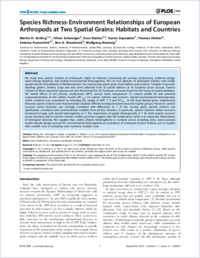Species richness-environment relationships of european arthropods at two spatial grains: habitats and countries
- Entling, Martin H. Institute for Environmental Sciences, University of Koblenz-Landau, Landau/Pfalz, Germany - Community Ecology, University of Bern, Switzerland
- Schweiger, Oliver UFZ, Helmholtz Centre for Environmental Research, Department of Community Ecology, Halle, Germany
- Bacher, Sven Community Ecology, University of Bern, Switzerland - Ecology and Evolution Unit, University of Fribourg, Switzerland
- Espadaler, Xavier Animal Biodiversity Group, Ecology Unit and CREAF, Autonomous University of Barcelona, Bellaterra, Spain
- Hickler, Thomas Biodiversity and Climate Research Centre (BiK-F) & Senckenberg Gesellschaft für Naturforschung & Department of Physical Geography at Goethe University, Frankfurt/Main, Germany
- Kumschick, Sabrina Community Ecology, University of Bern, Switzerland - Centre of Excellence for Invasion Biology, Department of Botany and Zoology, Stellenbosch University, Matieland, South Africa
- Woodcock, Ben A. NERC Centre for Ecology & Hydrology, Wallingford, Oxfordshire, United Kingdom
- Nentwig, Wolfgang Community Ecology, University of Bern, Switzerland
-
24.09.2012
Published in:
- PLoS ONE. - 2012, vol. 7, no. 9, p. e45875
English
We study how species richness of arthropods relates to theories concerning net primary productivity, ambient energy, water-energy dynamics and spatial environmental heterogeneity. We use two datasets of arthropod richness with similar spatial extents (Scandinavia to Mediterranean), but contrasting spatial grain (local habitat and country). Samples of ground-dwelling spiders, beetles, bugs and ants were collected from 32 paired habitats at 16 locations across Europe. Species richness of these taxonomic groups was also determined for 25 European countries based on the Fauna Europaea database. We tested effects of net primary productivity (NPP), annual mean temperature (T), annual rainfall (R) and potential evapotranspiration of the coldest month (PETmin) on species richness and turnover. Spatial environmental heterogeneity within countries was considered by including the ranges of NPP, T, R and PETmin. At the local habitat grain, relationships between species richness and environmental variables differed strongly between taxa and trophic groups. However, species turnover across locations was strongly correlated with differences in T. At the country grain, species richness was significantly correlated with environmental variables from all four theories. In particular, species richness within countries increased strongly with spatial heterogeneity in T. The importance of spatial heterogeneity in T for both species turnover across locations and for species richness within countries suggests that the temperature niche is an important determinant of arthropod diversity. We suggest that, unless climatic heterogeneity is constant across sampling units, coarse-grained studies should always account for environmental heterogeneity as a predictor of arthropod species richness, just as studies with variable area of sampling units routinely consider area.
- Faculty
- Faculté des sciences et de médecine
- Department
- Département de Biologie
- Language
-
- English
- Classification
- Ecology and biodeversity
- License
-
License undefined
- Identifiers
-
- RERO DOC 30408
- DOI 10.1371/journal.pone.0045875
- Persistent URL
- https://folia.unifr.ch/unifr/documents/302514
Statistics
Document views: 119
File downloads:
- pdf: 151
